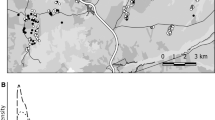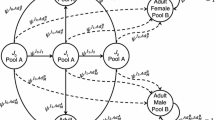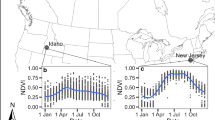Abstract
Life-history theory predicts that animals should develop adaptive trade-offs between survival and reproduction to maximize their fitness. This results in a continuum of life-history strategies among species, ranging from slow to fast paces-of-life. The optimal pace-of-life has been shown to vary within environmental gradients, with a commonly observed pattern of a slow-to-fast continuum from the tropics to the poles. Within species, pace-of-life variability has however received much less attention. In this study, we investigated whether or not the pace-of-life of populations within a species follows the expected slow–fast continuum associated with latitude. We analysed the variability of life-history strategies among populations of the European roller Coracias garrulus, a long-distance migratory species, comparing breeding parameters and adult survival between populations across a latitudinal gradient. The findings showed a negative correlation between survival and clutch size in roller populations, with a slower pace-of-life in the northern populations and a faster pace-of-life in the southern populations: a reverse gradient to what might be expected from inter-specific studies. These results suggest that northern populations would benefit from measures enhancing adult survival probability, such as reduction in harvesting rates, while southern populations would respond better to actions favouring reproductive success, such as nesting site provisioning. This study highlights that life-history traits can vary substantially between populations of a single species with a large latitudinal breeding range, and pinpoint how knowledge about this variability may be key in anticipating different populations’ responses to threats as well as to conservation strategies.



Similar content being viewed by others
Availability of data and materials
The data that support the findings of this study are available on request from the corresponding author.
References
Ardia DR (2005) Tree swallows trade off immune function and reproductive effort differently across their range. Ecology 86:2040–2046
Avilès JM, Sanchez A (1997) Evolución del número de parejas reproductoras de Carraca Coracias garrulus en cinco hábitats de Extremadura. Butlletí Del Grup Catalá D’anellament 14:25–29
Avilés JM, Sanchez JM, Sanchez A, Parejo D (1999) Breeding biology of the Roller Coracias garrulus in farming areas of the southwest Iberian Peninsula. Bird Study 46:217–223
Avilès JM, Sanchez JM, Parejo D (2000) The Roller Coracias garrulus in Extremadura Sw of Spain does not show a preference for breeding in clean nest-boxes. Bird Study 47:252–254
Badyaev AV, Ghalambor CK (2001) Evolution of life histories along elevational gradients: trade-off between parental care and fecundity. Ecology 82:2948–2960
Bechet A, Giroux J-F, Gauthier G, Nichols JD, Hines JE (2003) Spring hunting changes the regional movements of migrating greater snow geese. J Appl Ecol 40:553–564
Beston JA (2011) Variation in life history and demography of the American black bear. J Wildl Manag 75(7):1588–1596. https://doi.org/10.1002/jwmg.195
Bivand RS, Wong DWS (2018) Comparing implementations of global and local indicators of spatial association. TEST 27:716–748
Boyce MS, Perrins CM (1987) Optimizing great tit clutch size in a fluctuating environment. Ecology 68:142–153
Boyle AW, Sandercock BK, Martin K (2016) Patterns and drivers of intraspecific variation in avian life history along elevational gradients: a meta-analysis: avian life-history variation along elevational gradients. Biol Rev 91:469–482
Burnham KP, Anderson DR (2004) Multimodel inference: understanding AIC and BIC in model selection. Sociol Methods Res 33:261–304
Capinera JL, Horton DR (1989) Geographic variation in effects of weather on grasshopper infestation. Environ Entomol 18:8–14
Carrillo J, Gonzalez-Davila E (2009) Latitudinal variation in breeding parameters of the common kestrel Falco tinnunculus. Ardeola 56:215–228
Caswell H (2000) Prospective and retrospective perturbation analyses: their roles in conservation biology. Ecology 81:619–627
Catry T, Catry I (2019) Nest-site provisioning re-shapes species interactions within bird assemblages. Ibis 161:699–704
Catry I, Catry T, Granadeiro JP, Franco AMA, Moreira F (2014) Unravelling migration routes and wintering grounds of European rollers using light-level geolocators. J Ornithol 155:1071–1075
Catry I, Sampaio A, Silva MC, Moreira F, Franco AMA, Catry T (2018) Combining stable isotope analysis and conventional techniques to improve knowledge of the diet of the European Roller Coracias garrulus. Ibis 161:272–285
Cayuela H, Arsovski D, Thirion JM, Bonnaire E, Pichenot J, Boitaud S, brison AL, Miaud C, Joly P, Besnard A (2016) Contrasting patterns of environmental fluctuation contribute to divergent life histories among amphibian populations. Ecology 97:980–991
Clobert J, Garland T, Barbault R (1998) The evolution of demographic tactics in lizards: a test of some hypotheses concerning life history evolution. J Evol Biol 11:329–364
Cooch EG, White GC (2017) Program MARK: a gentle introduction
Cramp S (1985) Coracias garrulous: Roller. Handbook of the birds of Europe the Middle East and North Africa Volume IV Terns to Woodpeckers. Oxford University Press, Oxford
Dammhahn M, Dingemanse NJ, Niemelä PT, Réale D (2018) Pace-of-life syndromes: a framework for the adaptive integration of behaviour, physiology and life history. Behavior Ecol Sociobioly. https://doi.org/10.1007/s00265-018-2473-y
den Boer PJ (1968) Spreading of risk and stabilization of animal numbers. Acta Biotheor 18:165–194
Dhondt AA (2012) Interspecific competition in birds. Oxford University Press, Oxford, New York
Durango S (1946) The Roller (Coracias garrulus L.) in Sweden. Vår Fågelvärld 5:145–190
Emmenegger T, Mayet P, Duriez O, Hahn S (2013) Directional shifts in migration pattern of rollers (Coracias garrulus) from a western European population. J Ornithol 155:427–433
Fielding DJ, Brusven MA (1990) Historical analysis of grasshopper (orthoptera: acrididae) population responses to climate in Southern Idaho, 1950–1980. Environ Entomol 19:1786–1791
Finch T, Saunders P, Avilés JM, Bermejo A, Catry I, de la Puente J, Emmenegger T, Mardega I, Mayet P, Parejo D, Račinskis E, Rodríguez-Ruiz J, Sackl P, Schwartz T, Tiefenbach M, Valera F, Hewson C, Franco A, Butler SJ (2015) A pan-European, multipopulation assessment of migratory connectivity in a near-threatened migrant bird. Divers Distrib 21:1051–1062
Finch T, Dunning J, Kiss O, Račinskis E, Schwartz T, Sniauksta L, Szekeres O, Tokody B, Franco A, Butler SJ (2017) Insights into the migration of the European Roller from ring recoveries. J Ornithol 158:83–90
Finch T, Branston C, Clewlow H, Dunning J, Franco AM, Račinskis E, Schwartz T, Butler SJ (2019) Context-dependent conservation of the cavity-nesting European Roller. Ibis 161:573–589
Gameiro J, Franco AMA, Catry T, Palmeirim JM, Catry I (2020) Long-term persistence of conservation-reliant species: Challenges and opportunities. Biol Conserv. https://doi.org/10.1016/j.biocon.2020.108452
Gauthier G, Pradel R, Menu S, Lebreton J-D (2001) Seasonal survival of greater snow geese and effect of hunting under dependence in sighting probability. Ecology 82:3105–3119
Ghalambor CK, Martin TE (2001) Fecundity-survival trade-offs and parental risk-taking in birds. Science 292:494–497
Griebeler EM, Caprano T, Böhning-Gaese K (2010) Evolution of avian clutch size along latitudinal gradients: do seasonality, nest predation or breeding season length matter? J Evol Biol 23:888–901
Heibo E, Magnhagen C, Vøllestad LA (2005) Latitudinal variation in life-history traits in Eurasian Perch. Ecology 86:3377–3386
Herrero JA, Kranz A, Skumatov D, Abramov AV, Maran T, Monakhov VG (2016) Martes martes. The IUCN Red List of Threatened Species
IUCN (2016) Coracias garrulus: BirdLife International: The IUCN Red List of Threatened Species 2017:e.T22682860A111884908. https://doi.org/10.2305/IUCN.UK.2017-1.RLTS.T22682860A111884908.en
Jackson CH (2011) Multi-state models for panel data: the msm package for R. J Stat Softw 38:1–29
Järvinen A, Jarvinen A (1986) Clutch size of passerines in harsh environments. Oikos 46:365
Jetz W, Sekercioglu CH, Böhning-Gaese K (2008) The worldwide variation in avian clutch size across species and space. PLoS Biol. https://doi.org/10.1371/journal.pbio.0060303
van de Kerk M, de Kroon H, Conde DA, Jongejans E (2013) Carnivora population dynamics are as slow and as fast as those of other mammals: implications for their conservation. PLoS ONE. https://doi.org/10.1371/journal.pone.0070354
King CM, Moors PJ (1979) The life-history tactics of mustelids, and their significance for predator control and conservation in New Zealand. New Zealand J Zoology 6:619–622
Kovacs A, Barov B, Orhun C, Gallo-Orsi U (2008) International species action plan for the European roller Coracias garrulus garrulus. Besenyotelek, Hungary
Lack D (1947) The significance of clutch-size. Ibis 89:302–352
Lebreton J-D (2005) Dynamical and statistical models for exploited populations. Aust N Z J Stat 47:49–63
Leggett WC, Carscadden JE (1978) Latitudinal variation in reproductive characteristics of American Shad ( Alosa sapidissima ): evidence for population specific life history strategies in fish. J Fish Res Board Can 35:1469–1478
Lüütsepp G, Kalamees A, Lüütsepp O (2011) European roller Coracias garrulus in Estonia 2000–2011. Hirundo 24:61–72
Manlik O, Lacy RC, Sherwin WB (2018) Applicability and limitations of sensitivity analyses for wildlife management. J Appl Ecol 55:1430–1440
Martin M, Drake A, Rock CA, Green DJ (2019) Latitudinal gradients in some, but not all, avian life history traits extend into the Arctic. Ibis. https://doi.org/10.1111/ibi.12789
Martin PR, MCKay JK (2004) Latitudinal variation in genetic divergenc of populations and the potential for future speciation. Evolution 58:938–945
McKinnon L, Smith PA, Nol E, Martin JL, Doyle FI, Abraham KF, Gilchrist HG, Morrison RIG, Bety J (2010) Lower predation risk for migratory birds at high latitudes. Science 327:326–327
Monti F, Nelli L, Catoni C, Dell’Omo G (2019) Nest box selection and reproduction of European Rollers in Central Italy: a 7 year study. Avian Res. https://doi.org/10.1186/s40657-019-0150-0
Montiglio P-O, Dammhahn M, Dubuc Messier G, Réale D (2018) The pace-of-life syndrome revisited: the role of ecological conditions and natural history on the slow-fast continuum. Behav Ecol Sociobiol 72:116
Moran PAP (1950) A test for the serial independence of residuals. Biometrika 37(1/2):178. https://doi.org/10.2307/2332162
Nevoux M, Forcada J, Barbraud C, Croxall J, Weimerskirch H (2010) Bet-hedging response to environmental variability, an intraspecific comparison. Ecology 91:2416–2427
Nur N (1988) The cost of reproduction in birds: an examination of the evidence. Ardea 55:155–168
Oli MK, Dobson FS (2003) The relative importance of life-history variables to population growth rate in mammals: Cole’s prediction revisited. Am Nat 161:422–440
Parejo D, Danchin E, Avilés JM (2005) The heterospecific habitat copying hypothesis: can competitors indicate habitat quality? Behav Ecol 16:96–105
Pradel R (1996) Utilization of capture-mark-recapture for the study of recruitment and population growth rate. Biometrics 52:703
Promislow DEL, Harvey PH (1990) Living fast and dying young: a comparative analysis of life-history variation among mammals. J Zool 220:417–437
R Core Team (2017) R: a language and environment for statistical computing. R Foundation for Statistical Computing, Vienna, Austria
Račinskis E, Mardega I (2017) Status of the European Roller in Latvia. Kecskemét, Hungary
Ricklefs RE (1997) Comparative demography of New World populations of thrushes (Turdus spp.). Ecol Monogr 67:23–43
Rodríguez-Ruiz J, Expósito-Granados M, Avilés JM, Parejo D (2020) Apparent survival, growth rate and dispersal in a declining European Roller population. J Ornithol 161:103–113
Rodríguez-Ruiz J, de la Puente J, Parejo D, Valera F, Calero-Torralbo MA, Reyes-González JM, Zajková Z, Bermejo A, Avilés JM (2014) Disentangling migratory routes and wintering grounds of iberian near-threatened European Rollers Coracias garrulus. PLoS ONE. https://doi.org/10.1371/journal.pone.0115615
Roff DA (2002) Life history evolution. Sinauer Associates, Sunderland, Mass
Sæther B-E, Bakke Ø (2000) Avian life history variation and contribution of demographic traits to the population growth rate. Ecology 81:642–653
Salgado-Ortiz J, Marra PP, Sillett TS, Robertson RJ (2008) Breeding ecology of the Mangrove warbler (Dendroica petechia bryanti) and comparative life history of the yellow warbler subspecies complex. Auk 125:402–410
Salguero-Gómez R, Jones OR, Jongejans E, Blomberg SP, Hodgson DJ, Mbeau-Ache C, Zuidema PA, de Kroon H, Buckley YM (2016) Fast–slow continuum and reproductive strategies structure plant life-history variation worldwide. Proc Natl Acad Sci 113:230–235
Schaffer WM (1974) Optimal reproductive effort in fluctuating environments. Am Nat 108:783–790
Seber GAF (1982) The estimation of animal abundance and related parameters, 2nd edn. Chapman, London and Macmillan, New York
Sepp T, McGraw KJ, Kaasik A, Giraudeau M (2018) A review of urban impacts on avian life-history evolution: does city living lead to slower pace of life? Glob Change Biol 24:1452–1469
Slatkin M (1974) Hedging one’s evolutionary bets. Nature 250:704–705
Sosnowski J, Chmielewski S (1996) Breeding biology of the Roller Coracias garrulus in Puszcza Pilicka forest (centra Poland). Acta Ornithologica 31:119–132
Stahl JT, Oli MK (2006) Relative importance of avian life-history variables to population growth rate. Ecol Model 198:23–39
Starrfelt J, Kokko H (2012) Bet-hedging-a triple trade-off between means, variances and correlations. Biol Rev 87:742–755
Stearns SC (1992) The evolution of life histories. Oxford University Press, Oxford New York
Tarantovich MV (2016) Peculiarities of nutrition and chicks feeding of European Roller (Coracias garrulus) in Belarus. Berkut 25:45–49
Tokody B, Butler SJ, Finch T, Folch A, Schneider TC, Schwartz T, Valera F, Kiss O (2017) The flyway action plan for the European Roller (Coracias garrulus). BirdLife Hungary (MME)
Unander S, Pedersen ÅØ, Soininen EM, Descamps S, Hörnell-Willebrand M, Fuglei E (2016) Populations on the limits: survival of Svalbard rock ptarmigan. J Ornithol 157:407–418
Václav R, Valera F, Martínez T (2011) Social information in nest colonisation and occupancy in a long-lived, solitary breeding bird. Oecologia 165:617–627
Venables WN, Ripley BD, Venables WN (2002) Modern applied statistics with S, 4th edn. Springer, New York
Vincent-Martin N, Gimenez O, Besnard A (2013) Reproduction et dynamique de colonisation du rollier d’Europe en cavites artificielles. In: Tatin L, Wolff A, Boutin J, Colliot E, Dutoit T (eds) Ecologie et conservation d’une steppe méditerranéenne, La plaine de Crau. Quae, Versailles, pp 103–114
White GC, Burnham KP (1999) Program MARK: survival estimation from populations of marked animals. Bird Study 46:S120–S139
Wiersma P, Munoz-Garcia A, Walker A, Williams JB (2007) Tropical birds have a slow pace of life. Proc Natl Acad Sci 104:9340–9345
Wikelski M, Spinney L, Schelsky W, Scheuerlein A, Gwinner E (2003) Slow pace of life in tropical sedentary birds: a common garden experiment on four stonechat populations from different latitudes Proceedings of the Royal Society of London. Series B. Biol Sci 270:2383–2388
Williams GC (1966) Natural selection, the costs of reproduction, and a refi nement of Lack’s principle. Am Nat 100:687–690
Acknowledgements
We would like to thank Dr Laura Benestan for her useful comments on the manuscript. We are also grateful to the Groupe Ornithologique du Roussillon, Patrick Mayet, Juan Rodríguez and Mónica Expósito, all the national park rangers involved in the field, BirdLife Hungary volunteers and ringers, and the numerous A Rocha France interns, students, and volunteers who participated in the fieldwork. We also thank the National Parks of Bükk, Kiskunság, Hortobágy, Körös-Maros, and Duna-Ipoly for their contribution to the fieldwork and allowing us to work on national park grounds. Two anonymous reviewers provided useful comments which improved an earlier version of this paper.
Funding
Fieldwork in Hungary was supported by LIFE13/NAT/HU/000081 and HU-SRB/0901/122/120. Financial support was provided by FCT/MCTES through national funding to CESAM (UID/AMB/50017/2019) and InBIO (UID/BIA/50027/2013 and POCI-01–0145-FEDER-006821). TC and IC were also supported by FCT (contract IF/00694/2015 and DL57/2016/CP1440/CT0023, respectively), and OK was supported by a grant (NKFI KH 130338).
Author information
Authors and Affiliations
Contributions
TS, IC, and AB conceived the ideas; all authors contributed substantially to the fieldwork methodology and data collection; TS analysed the data; TS, IC, and AB led the writing of the manuscript. All authors contributed critically to the drafts and gave final approval for publication.
Corresponding author
Ethics declarations
Conflict of interest
The authors declare that they have no conflict of interest.
Ethical approval
“All applicable institutional and/or national guidelines for the care and use of animals were followed.”
Additional information
Communicated by Thomas Koert Lameris.
Supplementary Information
Below is the link to the electronic supplementary material.
Rights and permissions
About this article
Cite this article
Schwartz, T., Besnard, A., Avilés, J.M. et al. Geographical variation in pace-of-life in a long-distance migratory bird: implications for population management. Oecologia 197, 167–178 (2021). https://doi.org/10.1007/s00442-021-05012-8
Received:
Accepted:
Published:
Issue Date:
DOI: https://doi.org/10.1007/s00442-021-05012-8




